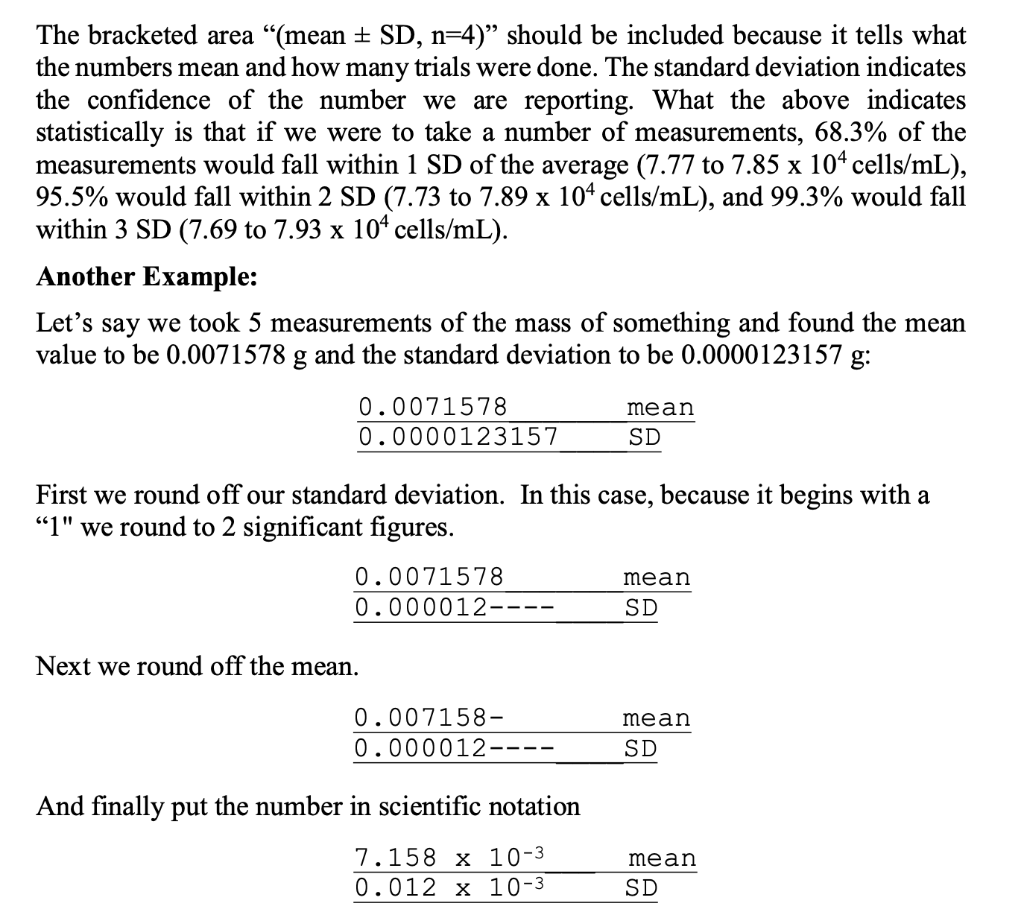The following volumes were obtained for the calibration of a 10 - mL pipet: 10.028415, 10.140035, 10.091111, and 10.012213 mL. Calculate the mean value, the standard deviation and then report your value. (Refer to pg 15 and 16 of the lab manual for how to calculate the standard deviation and how to correctly report your value.)? (Show each step of the calculation) Please, it needs to be solved the way below



The results should be reported as: (7.1580.012)103g(meanSD,N=5) of trials minus one. Since 4 trials (N) were done on the sample, we would divide by 3 . When calculating your SD, round off only at the end of the calculation when you are ready to report your value. (For example, we did not round 5752=330626 down to 330000 in the above calculation.) Once we have calculated the mean and standard deviation, we must report it properly. There are different conventions for how to report the mean and standard deviation. For this lab class, use the following method: 1. Calculate the value of the mean (78075 cells /mL) and then the value of the standard deviation (434.932945 cells /mL) without rounding off. 2. Round the standard deviation to one significant figure unless the SD begins with a "1". (In this case the 434.93 gets rounded to the hundreds place value, as is shown below.) If your SD value begins with a "1", then round off to 2 significant figures. (For example, if the SD was calculated to be 120.33, then the value would be rounded to 1.2102 ) 3. Round the mean to the same place value as the rounded standard deviation position. In this case, because we rounded the standard deviation to the hundreds place value, we will round the mean to the same place value position. The bracketed area "( meanSD,n=4) " should be included because it tells what the numbers mean and how many trials were done. The standard deviation indicates the confidence of the number we are reporting. What the above indicates statistically is that if we were to take a number of measurements, 68.3% of the measurements would fall within 1SD of the average (7.77 to 7.85104 cells /mL), 95.5% would fall within 2SD(7.73 to 7.89104cells/mL), and 99.3% would fall within 3SD(7.69 to 7.93104 cells /mL). Another Example: Let's say we took 5 measurements of the mass of something and found the mean value to be 0.0071578g and the standard deviation to be 0.0000123157g : First we round off our standard deviation. In this case, because it begins with a "1" we round to 2 significant figures. Next we round off the mean. And finally put the number in scientific notation 3. Round the mean to the same place value as the rounded standard deviation position. In this case, because we rounded the standard deviation to the hundreds place value, we will round the mean to the same place value position. 4. Put the values into scientific notation, using the same scientific notation for both the mean and the standard deviation. Report the value as the mean the standard deviation. If scientific notation is used, place the mean and standard deviation in brackets and include the scientific notation after the brackets. Units must be included and then followed by a bracket that defines what the numbers mean. Therefore the results should be reported as: (7.810.04)104cells/mL(meanSD,N=4)










